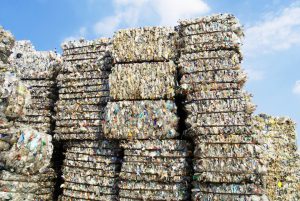
Out of the 33 million tons of plastic we generate every year, less than 10 percent actually gets recycled.
Recycling plastic is a no-brainer these days. Theoretically, it should be pretty easy. Use up the product, rinse out the container, toss it in the recycling bin. Voila! Off it goes to its inevitable reincarnation. Simple, right?
Not so fast. The reality is unfortunately far more complicated. Americans are locked into a dysfunctional relationship with plastic. Collectively, we generate approximately 33 million tons of plastic trash each year, but less than 10 percent of that actually gets recycled. And even if you wantto recycle the stuff, the multiple types—polyethylene, polypropylene, polystyrene, and so forth—lead to confusion about how and what plastics can successfully be accepted by most recycling programs. This is a common problem with food containers: Are those plastic clamshells that contain greens recyclable? What about that yogurt container? And that ketchup bottle—can the lid go in the blue bin, too? It’s confusing.
“I think the public cares, but they have no idea what the numbers at the bottom of plastics mean,” says Mitch Hedlund, executive director of Recycle Across America, an advocacy group that has created a standardized labeling system for recycling bins. “There is a lack of national communication to help the public know the difference between plastics—what is recyclable and what’s not.”
So what’s an ecologically minded person to do? Crucially, the less plastic you can use, the better. And when it comes to the old “paper or plastic?” question, there’s no debate: “Paper and cardboard are amazing if they’re recycled,” Hedlund says. That’s because paper can be easily remade, and more people understand how to properly recycle it. (Though, as Hedlund points out, paper should be kept separate from other recycling to avoid touching food residue and other contaminants.)
Consuming less overall, choosing paper when given the option, and making recycling easier to understand may sound like simple solutions for the plastic problem, and that’s exactly the point. “We’re in a great position to make a change,” says Hedlund. “But we need everybody to start unifying around common-sense solutions.” Eventually, she explains, a critical mass of people changing their habits creates change. “My five-year goal is for people to say, ‘Remember when recycling was confusing? Remember when most manufacturers weren’t closing the loop? Remember when there was more plastic going into the oceans than there was going into remanufacturing?’” It’s a noble dream—and, with a collective effort, a possible reality.
Want to make sure you’re recycling correctly? The first step is to check with your recycling hauler to make sure you understand their rules—every program is different. With that said, Recycle Across America has pulled together some general guidelines. Below, we’ve pulled those that specifically relate to food and beverage containers:
- Make sure all items are rinsed and clean before going into the recycling bin. Absolutely no food, liquids, or other contamination allowed. Yes, that means that the bottom of your pizza box needs to go in the compost (or the trash). You can, however, tear-off any non-greasy parts for disposable in the recycling bin.
- Separate glass jars from their metal lids.
- Inquire about how to recycle the lids of plastic bottles. In bigger, mixed systems, it’s often preferred to keep them together, but many smaller programs only want the bottle, so the lid should go in the trash.
- Keep aluminum foil, plastic utensils, Styrofoam containers, plastic wrap, or plastic wrappers (including baggies and bags) OUT of the recycling bin. Those items need to go into the trash unless your recycling program specifically gives the green light.
- If you must collect your recycling in a plastic bag, use a clear or see-through blue bag.
- Compostable plastics are great but they don’t belong in a recycling bin (and not even in a home composting bin—only industrial or commercial composting options can take these items).


